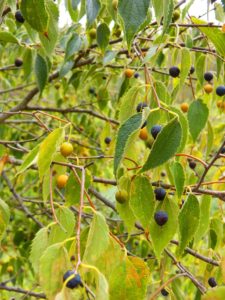Hackberry: Very Small Persons’ Climbing Wall
The Hackberry tree (Celtis occidentalis) is also known as sugarberry, beaverwood, nettetree, or false elm. The spreading canopy of the Hackberry has been compared to Einstein’s hair. It derives its name from the Scottish “hag” (witch) or hagberry tree, and some refer to the drooping bushy branches as “witches’ brooms.” However, rather than creepy, the Hackberry is hard-working and has an uncomplaining nature. This blog will explain why and also reveal a little secret about this corky-barked floodplain friend.
During my daughter’s short-lived ballerina phase, her favorite book was about a ballet school. The ballet teacher, Ms. Barwall, was stern but kind-hearted. The students were working hard, making mistakes, and growing character. In the background on every page was Mr. Ogletree, a small, bald-headed man with spectacles and a bowtie. Mr. Ogletree attended every lesson, playing the piano, and spoke only through the keys of his instrument. Mr. Ogletree was hard-working, reliable, and unassuming. . .just like the Hackberry.

The berries (known as drupes) turn from orange to dark purple when they ripen in the fall (Photo: Pixabay)
To say the Hackberry is hard-working would be a gross understatement. It provides food and shelter and serves as a host plant for many species. At least five species of butterflies rely on the Hackberry, including the Hackberry Emperor (Asterocampa celtis). Several species of birds also enjoy the fruits of the Hackberry (even in winter), including cedar waxwings, woodpeckers, mockingbirds, robins, and quail, and a variety of caterpillars enjoy munching on the Hackberry’s leaves. Hard-working indeed, but there’s more. . .
Traditionally, the boiled bark of the Hackberry had a variety of medicinal uses, including regulating menstrual cycles, treating colds and sore throats, and curing venereal diseases. In addition to the medicinal uses, Native Americans also used this substance for ceremonial purposes. The berries were used to concoct a porridge when mixed with corn and animal fats. If you partake of the dark purple berries, you may find they have a taste similar to dates. A colleague in PA tells me of a friend who blends them up to make a highly nutritious “Hackberry milk.” But wait, that’s not all. . .
While the wood of the Hackberry is not known as a high grade wood, it has been used for furniture, athletic goods, boxes, plywood, and firewood. Pioneers used it for barrel hoops and wood flooring for their cabins. The Hackberry has also been known to be used for bonsai cultivation (here’s how: https://www.bonsaiempire.com/tree-species/celtis).
Of course, those of us in the environmental business know the Hackberry quite well for its almost ubiquitous presence along our floodplains. In this way, it is helping with flood resilience and holding floodplain soils in place. In these soils, the Hackberry grows rapidly, reaching heights up to 100 feet (although the average height in other settings is closer to 40 to 60 feet). It is used often by some restoration practitioners for riparian projects.
For all of this, the Hackberry is uncomplaining, able to withstand all manner of abuses, including wind, pollution, heat, salt, and poor soils. Just like Mr. Ogletree at his piano, the Hackberry always shows up and does its job.
And, to top it all off, the Hackberry also serves as a very small person’s climbing wall due to its ridgey, warty bark.
Now, here is the secret. My wife, Garnett, who is better attuned to nature’s subtleties than I, has actually seen very small people climbing on the Hackberries along our local river’s floodplain. This happens only in the few moments before dawn, and the phenomenon can easily be mistaken for birds scampering up the trunk. Luckily, she was able to capture the following image during one of these rare encounters.
David J. Hirschman: [email protected]
References
Butterflies and Moths of North America, Hackberry Emperor, Asterocampa celtis (Boisduval & Leconte, [1835]).
Interesting Facts About the Hackberry Tree, Sciencing, Damien Campbell, April 5, 2018.
Ladybird Johnson Wildflower Center, Plant Database, Celtis occidentalis.
The Common Hackberry – An Urban Tree That Isn’t So Common, LEAF (Local Enhancement and Appreciation of Forests), Brenna Anstett, March 12, 2018.



